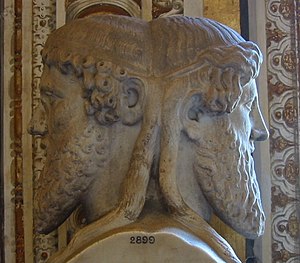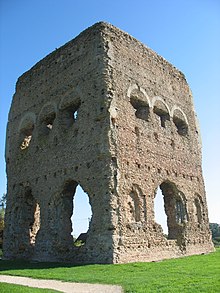Janus

In Roman mythology, Janus (or Ianus) was the god of gates, doors, doorways, beginnings and endings. His most prominent remnant in modern culture is his namesake, the month of January, which begins the new year. He is most often depicted as having two faces or heads, facing in opposite directions.
Origins and nature
Macrobius and Cicero attempted to explain the name as Latin deriving it from the verb ire ("to go").[1] It has been conjectured to be derived from the Indo-European root meaning transitional movement (cf. Sanskrit "yana-" or Avestan "yah-", likewise with Latin "i-" and Greek "ie-".).[2]
William Betham argued that the cult arrived from the Middle East and that Janus corresponds to the Baal-ianus or Belinus of the Chaldeans sharing a common origin with the Oannes of Berosus[3] and thus with the Mesopotamian figure of Uanna known from seventh century BCE texts.[4]
If Betham's eastern origin thesis is correct, the name ultimately derives from a form of the Mesopotamian name Uanna which in turn has been speculated to be derived from the name of the Biblical prophet Jonah (Hebrew Yonah meaning a dove)[5] who preached to the Assyrians over a century before the earlist mention of Uanna.
Janus was usually depicted with two heads facing in opposite directions. According to a legend,he had received the gift to see both future and past from the god Saturn in reward for the hospitality received.[citation needed] Janus-like heads of gods related to Hermes have been found in Greece, perhaps suggesting a compound god. These double headed figures have precursors in Assyrian depictions of Oannes with a human head in front and a fish head behind.[3]
The Romans associated Janus with the Etruscan deity Ani. However, he was one of the few Roman gods who had no ready-made counterpart, or analogous mythology. Several scholars suggest that he was likely the most important god in the Roman archaic pantheon: this is reflected in the appellation Ianus Pater, still used in Classical times. He was often invoked together with Iuppiter (Jupiter).
According to Macrobius and Cicero, Janus and Jana (Diana) are a pair of divinities, worshipped as the sun and moon, whence they were regarded as the highest of the gods, and received their sacrifices before all the others.[6]
In general, Janus was the patron of concrete and abstract beginnings of the world[7](such as the religion and the gods themselves), the human life,[8] new historical ages, and economical enterprises. He was also the god of the home entrance (ianua), gates, bridges and covered and arcaded passages (iani) named after him.
He was frequently used to symbolize change and transitions such as the progression of past to future, of one condition to another, of one vision to another, the growing up of young people, and of one universe to another. He was also known as the figure representing time because he could see into the past with one face and into the future with the other. Hence, Janus was worshipped at the beginnings of the harvest and planting times, as well as marriages, births and other beginnings. He was representative of the middle ground between barbarity and civilization, rural country and urban cities, and youth and adulthood.
Numa in his regulation of the Roman calendar called the first month Januarius after Janus, at the time the highest divinity. Numa also introduced the Ianus geminus (also Janus Bifrons, Janus Quirinus or Portae Belli) , a passage ritually opened at times of war, and shut again when Roman arms rested.[9] It formed a walled enclosure with gates at each end, situated in the Roman Forum which had been consecrated by Numa Pompilius. In the course of wars, the gates of the Janus were opened, and in its interior sacrifices and vaticinia were held to forecast the outcome of military deeds.[10] The doors were closed only during peacetime, an extremely rare event. Livy wrote in his Ab urbe condita that the doors of the temple had only been closed twice since the reign of Numa: firstly in 235 BC after the first Punic war and secondly in after the battle of Actium in 31 BC. A temple of Janus is said to have been consecrated by the consul Gaius Duilius in 260 BCE after the Battle of Mylae in the Forum Holitorium. The four-side structure known as the Arch of Janus in the Forum Boarium dates to the 4th century CE.
In the Middle Ages, Janus was also taken as the symbol of Genoa, whose Latin name was Ianua, as well as of other European communes.

Other myths
Janus was supposed to have shared a kingdom with Camese in Latium. They had many children, including Tiberinus.
When Romulus and his men kidnapped the Sabine women, Janus caused a volcanic hot spring to erupt, resulting in the would-be attackers being buried alive in the deathly hot, brutal water and ash mixture of the rushing hot volcanic springs that killed, burned, or disfigured many of Romulus' men. Romulus was in awe of the god's power. (Later on, however, Sabine and Rome became allies.) In honor of this, the doors of a walled roofless structure called 'The Janus' (not a temple) were kept open during war after a symbolic contingent of soldiers had marched through it. The doors were closed in ceremony when peace was concluded. Augustus and Nero both advertised universal peace, which had led to 'the closing of the Janus', during their reigns.
Contemporary Culture
The god Janus was featured in the Percy Jackson and the Olympians series of children books. In the fourth book, the Battle of the Labyrinth, Janus is introduced as a Greek (not Latin) Olympian.
See also
- Diprosopus – congenital disorder whereby part or all of the face is duplicated on the head; suggested as possible origin of Janus myth
- Janus Saves – a chapbook of poetry by Canadian author Brock Warner released in September, 2008.
- 39 Clues – a book that features "Janus" as a Cahill branch
- Holism
- Janus (US band) - US Rock Band
References
- ^ Macrobius, Saturnalia, I, 9, 11
- ^ Taylor, Rabun, "Watching the Skies: Janus, Auspication, and the Shrine in the Roman Forum," Memoirs of the American Academy in Rome vol. 45 (2000): p, 1.
- ^ a b Royal Numismatic Society, Proceedings of the Numismatic Society, James Fraser, 1837
- ^ Gerald Verbrugghe, John Moore Wickersham, Berossos and Manetho, Introduced and Translated: Native Traditions in Ancient Mesopotamia and Egypt, University of Michigan Press, 2001
- ^ H. Clay Trumbull, Journal of Biblical literature, Volumes 11-12, Society of Biblical Literature and Exegesis (U.S.), 1892
- ^ Macrobius Saturnalia i. 9; Cicero De Natura Deorum ii. 27.
- ^ According to Varro, in the carmen saliaris Janus is called "creator", as the initiator of the world itself. De lingua latina, VII, 26-27.
- ^ Macrobius defines him Consivium, i.e. propagator of the human genre. Saturnalia, I, 9, 16.
- ^ Horat. Carm. iv. 15. 8; Virg. Aen. vii. 607
- ^ Livy, History of Rome, I, 19, 2
Sources
- Dumézil, Georges (2001). La religione romana arcaica. Milan: Rizzoli. p. 291. ISBN 8817866377.
- Ferrari, Anna (2001). Dizionario di mitologia greca e latina. Milan: Rizzoli. ISBN 8817866377.
- Livius.org: Janus
- Translation of Ovid's Fasti, a section on January, and Janus
| Part of a series on |
| Roman mythology |
|---|
| Major gods |
| Topics |
| Other minor Roman deities |
|
|
